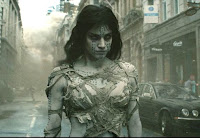Our three secret weapons are fear, surprise, and ruthless efficiency…
So, a few years back I attended the SDSU Writers’ Conference and got to listen to a gentleman named Esmund Harmsworth. Look him up. Nowadays he’s an agent at ZSH Literary.
He caught my attention one year when I attended a Q&A panel with a bunch of agents. The panel had been running for about half an hour when one fellow stood up and asked a question about his sci-fi novel. One agent immediately told him to throw it away and two others joined in. The trio of battleaxes berated the poor questioner and loudly declared genre as the absolute worst thing to write. Horror, sci-fi, fantasy—it was all garbage. Each of them stressed that they would never, ever look at a genre writer as a potential client.
After a few minutes of them going on and on, Mr. Harmsworth (on the far side of the platform) cleared his throat into his microphone. It tripped them up for a moment, and in the pause he pointed out to the questioner (who had, at this point, shrunk to a height of about two feet and was crying quietly to himself) that if you write something good any agent is going to want to see it. That’s their job, after all, and every agent on the panel was secretly hoping to find the next Stephen King. He sat back in his chair and the battleaxe brigade immediately backpedaled and agreed that quality writing was what mattered over everything else.
Needless to say, when I saw Harmsworth’s name on a seminar list the following year, I made a point of being there. Yeah, it was about mysteries, his chosen field, but I figured there’d be something to glean out of it. And there was, even though Harmsworth admitted halfway through that he’d really only had eight rules but the conference folks said ten looks a lot better on the seminar listings so he made up a couple to round out his list.
That being said—I’m not repeating his entire ten points. If you were in the room that day or have heard him give this little lecture since, don’t try posting an “AHA!!!” because I misnumbered something or left something out. I’m telling you now—things are probably misnumbered and left out.
Also, I can’t understand all the notes I wrote to myself seven years ago…
First Rule – There are no rules. Despite everything I’m about to recount, there is no “A-B-C-Done!” when it comes to writing. I’ve mentioned this here before. You can’t point to any rule of writing without acknowledging there are at least twenty examples of violating that rule. So if people are telling you “you must absolutely, always do this!”—especially when this relates to things like page counts or turning points or redemptive moments– it’s a sure sign they don’t know what they’re talking about.
Now, that being said… Agents sell books (and movies) by comparing them to books that have already sold. Makes sense—that’s how most of us buy books. So saying “it’s not like anything else” makes your manuscript very hard to sell. Your book needs to follow those rules you keep hearing about to some extent.
However… following all of the rules makes you a formula writer. Nothing wrong with that. Lots of people make a decent living writing formula books and formula television shows. Just be clear that no one’s going to sing the praises of such a thing or offer mega-millions for it. Formula manuscripts are the junk food of publishing and Hollywood. They sell steadily, no one pays a lot for them, and most folks forget them half an hour after they’re gone.
Second Rule – Know the difference between mysteries and thrillers. Agents sell your manuscript to publishers and producers, but you need to sell it to an agent. One of the key elements, of course, is to know what you’re selling. It can be a pain in the ass these days with some of the sub-sub-genres out there, but you should have a solid idea which one of them your story fits into. This is when you need be honest with yourself. It doesn’t matter how much you wanted to write a historical drama—if you’ve ended up with a low fantasy story that’s what it is and you need to admit it.
Different genres also tend to have different lengths. You can sell a horror novel that’s 115,000 words, but mystery novels should be topping out around 90,000.
Also, you should know who your audience is. Most mysteries are bought by women (they’re 80% of the sales), most thrillers are bought by men. If you’ve written a kick-ass thriller aimed solidly at a female audience, you’re fighting an uphill battle. Not an impossible one, mind you, but be aware of what you’re up against.
Third Rule – Have a real mystery. One telling thing that came up in this seminar—editors will reject a mystery if they can solve “whodunnit” before the hero does. The story needs to have real clues, red herrings, antagonists, foils—a good mystery isn’t just withheld information. It should involve a lot of thought by the reader—thoughts that a good writer will be guiding down the wrong paths.
As I’ve mentioned once or thrice before, mysteries also depend on strong characters. I need to care about Wakko or his finding clues and working out answers isn’t going to mean anything to me. Plus, if you think about it, most mysteries tend to be mystery series, and no one’s going to want to follow multiple adventures of a character who’s just not interesting or likeable.
Fourth Rule – Location is key to mysteries. Harmsworth summed this up in one neat line. Most mysteries take place somewhere people would go on a dream vacation. People read mysteries set in Las Vegas and Hawaii and New Orleans. These are places most people will read about regardless, and will love to see a clever story set there.
Keep in mind this dream setting can be manipulated a bit and can be represented by some industries or careers. Hollywood is a dream job for a lot of people, so it makes a great setting for mysteries. So is Washington, because we’re all curious about those hallways of power.
Make sure your story is set somewhere inherently interesting—and not just interesting to you.
Fifth Rule – The idea is key to thrillers. I’ve mentioned the term “high concept” here before. It’s when you can sum up the whole idea of a story in just one or two sentences. A great high concept idea doesn’t even need that much, which is how you end up with pitches like “big lizard, big apple,” “Jurassic Shark,” or “it’s like Die Hard in a building.”
A good thriller depends on a central idea that can be summed up in one or two lines. If it can’t, then the whole thing needs work. Because of this, thrillers tend to be very linear and don’t rely on a lot of subplots or a vast array of supporting characters. They’re driven by suspense and the mounting threat that was mentioned in that two-line pitch..
Sixth Rule – Be patient. You can write an amazing novel or clever screenplay and still have the bad luck of finishing it just as interest in said topic has dropped to an all-time low. Some people tried to jump on the supernatural romance boat just as Buffy and Angel were coming to a close, and… well, that ship got dry-docked for a couple of years. Then there was Twilight and suddenly that ship wasn’t just crewing up, it was press-ganging people.
If someone tells you that your book won’t sell, just put it away, go work on something else, and try submitting it again in four or five months. If it’s a good book it will sell eventually. Honest.
If it’s a good book.
And there you have it. Ten (more or less) tips on how to write better mysteries, many of which can be applied to almost any manuscript.
Next week, I’d like to tell you about the time I sat around for hours watching the most inefficient bank robbery ever.
Until then, go write.






